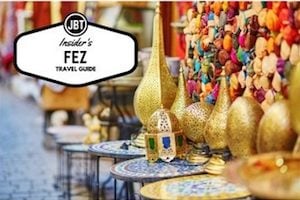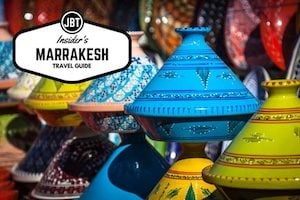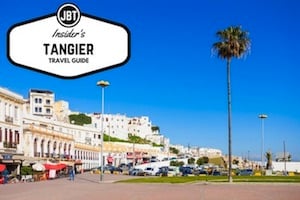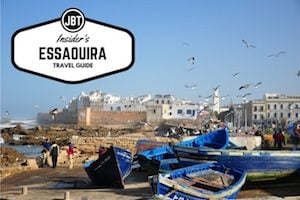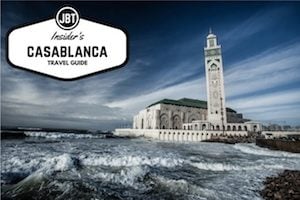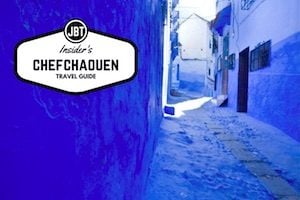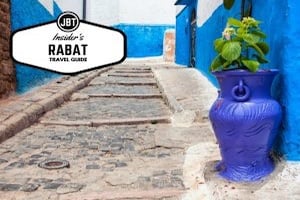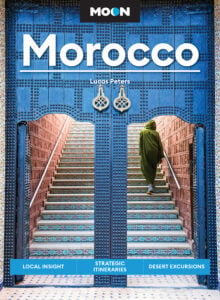
With its white walls and bright, broad main streets, its relaxed and friendly inhabitants, and its vibrant arts and music scene, Essaouira is my favorite city in Morocco. It has world-class kite-surfing, a beautiful beach and two major music festivals every year. Its atmosphere is unique for Morocco — a splendid mix of new and old, hippy and affluent — and it’s well-developed for tourism.
Yet despite so many great reasons to make the 3-hour journey from Marrakesh, most tourists don’t. I’m here to tell you that it’s well worth the effort. Skip the expensive, anonymous tour bus, spend 80 Dh (about $8) each way for the comfortable, modern, public bus, and put the money you’ll save into one night at a riad in Essaouira’s medina. Even if you can only spend 24 hours in Essaouira, there’s so much to do!
Wander the medina
Of course, you can do this in any Moroccan city. But unlike the dark, intimidating alleys of some other medinas, Essaouira’s are inviting, with friendly inhabitants and hidden treasures. Nowhere else will you walk down an unmarked street and in the middle of nowhere, find an art gallery, a hammam, a café, and children playing, all just a few feet apart from each other. The vast majority of shopkeepers here are outgoing but not aggressive, so you can enjoy “just looking” with a lot less stress than in Marrakesh.
Visit a Nomad Shop
No trip to Morocco is complete unless you’ve visited the premises of one of several nomad-owned shops in Essaouira. An especially good place is Grenne Shop at 17 Rue Ibn Rochd, not far from Place Moulay Hassan. Dressed in tribal robes, the proprietors are family members and their friends who rotate in and out of their desert lives to sell you things you didn’t know you wanted. Let yourself be invited in, joke with them, have tea and test your best bargaining skills against master salesmen. You’ll probably pay too much for something you hadn’t planned on buying, but you’ll cherish the item and every time someone asks where you got it, you’ll have a great story to share.
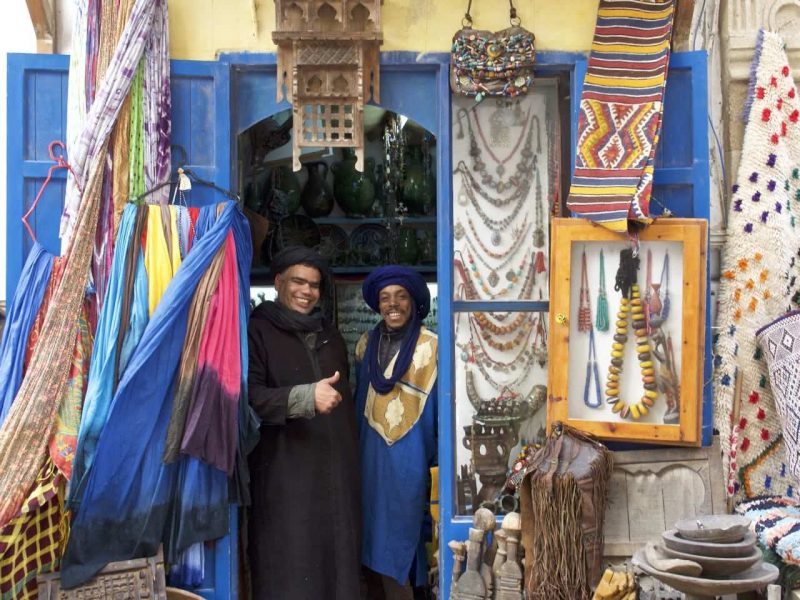
Visit a Spice Shop
There are hundreds of spice shops in Essaouira. Stall after stall has walls lined with jars, and most of them sell the same things, though the quality and price vary. Real saffron can be had for $6-7 per gram, but you have to trust the seller to be sure it’s not counterfeit. Two shops are safe bets: For the most authentic experience, Mohammed Seddiki (in the back of the fish and spice market off at Souk Jdid) is a dying breed, a master in the ancient, medicinal uses of spices who has been trained for decades to diagnose and treat health conditions with them. He also sells spices to many restaurants in Essaouira so his stock constantly turns over and is fresh. He speaks French but almost no English. For a more tourist-oriented shop, try Taraa Shop on Ave Mohamed ben Abdellah. Rachid, the owner, speaks good English and he’s very laid-back, letting you look without trying to sell you anything. Fair prices are marked on his jars, so you don’t have to worry about bargaining.
Buy Argan Oil
Yes, you can buy argan oil anywhere in Morocco, and perhaps you stopped at one of those huge tourist shops in the mountains along the roads to Marrakesh. But if you were smart enough to hold back then, Essaouira is the place to buy. At the shops on el Fechtaly by Souk Jdid, they actually bottle and sell the argan oil being produced by the ladies who sit outside their doors grinding the nuts; bottles are labeled with the production date. I recommend shop numbers 21 and 27, owned by the same business, because their prices are about the same as what my Moroccan friend in Casablanca pays for her argan oil, and the product is very fresh.
Visit a Synagogue
Rabbi Haïm Pinto, who died in 1845, was so important to the Jewish community here that every year, hundreds of Jews from around the world make a pilgrimage to his tomb. Though at one time 40% of Essaouira’s population was Jewish, as of March, 2018 it consists of exactly one man. Don’t be put off by the demolished buildings in Essaouira’s mellah (the Jewish quarter). There are 2 synagogues there which you can visit free, one of which was also Rabbi Pinto’s home and office. Pinto’s Torah, now over 200 years old, is still housed in the ark and services are occasionally held. Nearby is Slat Lkahal, which was the community synagogue. Both have been beautifully renovated and are an interesting look into Essaouira’s Jewish past. The caretakers speak a little English.
Soak Up the Music
The music in Essaouira ia everywhere: The young Moroccan men you’ll see in long dreadlocks and bushy beards are almost certainly musicians. Many restaurants are decorated with music memorabilia. Pass a CD shop and you’ll likely hear the latest from Mali or Senegal playing on a boom box. At least ten shops sell musical instruments from guitars to gimbri, a traditional 3-stringed bass. Buskers will serenade you with reggae or The Beatles while several restaurants offer live music in the evening. Trance-inducing Gnawa music, originally brought to Morocco by sub-Saharan slaves, is a part of Essaouira’s soul and every summer nearly a half-million people flock here for the Gnawa and World Music Festival of Essaouira. If you come on a weekend, there’s a reasonable chance that you’ll be able to see a free outdoor concert in Place Moulay Hassan, near the port.
Soak Up the Art
There are as many galleries in Essaouira as there are spice shops. Some are cooperatives that sell the work of local artists and many are owned by the artists themselves. Unlike most other places in Morocco, many artists and craftsmen are happy to let you photograph them at their work as long as you ask first, and most of them are even happier to talk with you if you’re willing to take a moment to say hello. The variety of painting styles is astounding, and many are native to Essaouira. A great place to check out a number of styles in one place is museum-like Galerie La Kasbah on Rue de Tétouan (you’ll see signs pointing the way when you get close), though you might get better prices in the smaller, artist-owned shops.
Buy Something Made from Thuya Wood
A significant percentage of Thuya tree wood products all over Morocco come from Essaouira. There are plenty of shops selling wood boxes, bowls, and furniture, but some of the more creative pieces are sold directly by the artists who make them. Walk some of the streets along the city’s walls, such as Rue Chbanate or Derb Koweit, and you’ll easily find these men sanding, cutting, or running a lathe in impossibly-tiny, dusty little workshops. Say hello and they’ll invite you in to see their work. Even better, support independent craftsmen and artists by buying something from them.
Visit the Port
In a world of factory fishing and global shipping, here is a place where hundreds of men go out in small, bright-blue boats at night and then sell whatever they’ve caught — dorado, prawns, rays, eels, crabs, and meter-long beltfish — to customers ranging from local families to restaurants in Marrakesh… to you! (see “Eat at the Port” below). Women wait patiently to buy buckets of sardines directly from the larger boats, while independent fishermen sell their catch on small tables and fend off marauding seagulls with sticks. It’s chaotic and wonderful to take in the aroma of fresh fish and watch the goings-on along with the hundreds of other people wandering the dock.
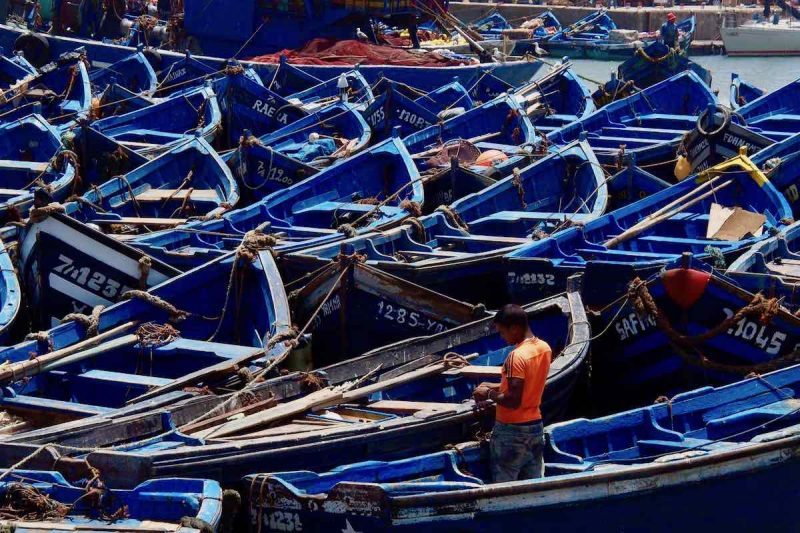
Eat at the Port
As long as you’re at the port, have lunch! Right there among the boats, you can have fish grilled and served to you at a little plastic table. You can buy the fish yourself and they’ll cook it for a small fee, or you can tell them what you’d like and they’ll tell you the price. Though it’s a bit more expensive than doing the same thing at the fish market in the middle of town, the atmosphere is fun and memorable.
Walk on the Beach
A long, sandy beach lies just outside the medina. You’ll see kite surfers on the water and horses or dromedaries on the sand. If you’re lucky you can watch people from all over the world in a kite surfing competition. The best time to walk the beach is in the morning when the winds are calmer.
Have a Unique Dinner Experience
If you’re spending the night, plan ahead and make a reservation at Café Caravane, owned by French painter Didier Spindler, whose personality and clothing are as colorful as his paintings. Café Caravane is almost an art gallery in itself, each room uniquely decorated (Spindler’s actual gallery is across the street). Plan to stay for the evening and enjoy a local band called Group Labas that starts out playing Andalusian-style and later shifts to Gnawa music as one of the waiters, playing a set of iron castanets called krakebs, sings, dances, and gets the patrons involved. On top of that, there’s a fire dancer and a magician! If you want to be in the middle of things, reserve well ahead for one of the few tables in the center area downstairs; for more quiet, ask for one of the side rooms. Daniel, the maitre d’, insists that if you don’t like your dish, to please let your waiter know and they will gladly serve you something else.
Essaouira isn’t big — you can cross the entire medina through the main street in about 10 minutes — and with 24 hours in Essaouira you can do everything listed above. The main thing you’ll regret is not having more time to spend in this beautiful town!
About the Author
 Since retiring in late 2016 from a career in IT, Mike Bernhardt has been visiting other cultures and writing about what he finds. When he’s not traveling he cooks international cuisine, plays his guitar, and on rainy days assists itinerant earthworms to cross the road.
Since retiring in late 2016 from a career in IT, Mike Bernhardt has been visiting other cultures and writing about what he finds. When he’s not traveling he cooks international cuisine, plays his guitar, and on rainy days assists itinerant earthworms to cross the road.
You can read about his adventures at travelingwithmikeandyvonne.com.

